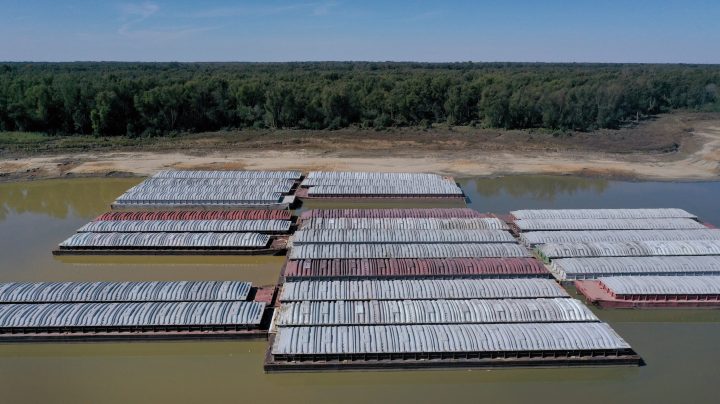
Low Mississippi River water levels drive up shipping costs
Low Mississippi River water levels drive up shipping costs

Water levels on the Mississippi River have reached historic lows in recent weeks because of a drought affecting more than half of the country. The Mississippi is a critical pathway for all kinds of agricultural products, including grains and soy beans.
Despite a bit of relief, thanks to some recent rain, the cost of shipping those goods on the river remains high. And with fears of global food shortages following Russia’s invasion of Ukraine, the troubles on the Mississippi come at an especially bad time.
“Normally, it costs about 80 cents to get the soybeans or the corn from where I’m at to New Orleans,” said Allen Pace, a farmer who grows corn, soy and wheat on his farm in LaCenter, Kentucky, just a few miles from where the Ohio River empties into the Mississippi. “This year, it’s costing close to between $2.50 and $2.90 for the same bushel to go down the river.”
But the low water levels on the Mississippi have left him with fewer shipping options, so he’s paying a lot more to send his harvest by barge. He’s feeling the higher cost of transport in the other direction too — paying more for products like fertilizer coming up the Mississippi.
“I think they call it farming,” Pace said. “It’s pretty tough when you get squeezed on both ends.”
The Mississippi moves about 60% of the U.S. soy and corn bound for other parts of the world, according to the USDA.
For soy alone, most U.S. exports are sent abroad between September and February, according to Mike Steenhoek, executive director of the Soy Transportation Coalition.
“This is game time for the U.S. soybean industry and the fact that our inland waterways system is still not operating as normal – it’s analogous to attaching a garden hose to a fire hydrant,” Steenhoek said.
Most barges can easily accommodate at least 50,000 bushels, “but every time you have 1 foot less of water at your disposal, you are putting 5,000 fewer bushels of soybeans per barge out of concern that if you load these barges to their normal standards, you could encounter a grounding. You could scrape the bottom,” he said.
Steenhoek said some sections of the Mississippi, especially south of St. Louis, have lost about 3 feet of depth in places that are normally 12 feet deep.
“That means 15,000 fewer bushels of soybeans per barge, which is a significant reduction in the cargo carrying capacity of an individual barge,” he said.
And fewer barges are moving along the Mississippi because the river also isn’t as wide as it normally is.
“There is no quick solution to this,” said Jason Miller, interim chairperson for the Department of Supply Chain Management at Michigan State University. “Many people would say, ‘Well, why don’t we just, you know, send all the grain by train down to New Orleans?’ Well, there’s only so much rail capacity.”
He said that limited capacity can make rail transport prohibitively expensive as an alternative to shipping by barge.
“So in some instances, you may be better off just storing it,” Miller said.
That’s exactly what many farmers are choosing to do as they wait for shipping costs to fall.
Jeff Worsham, a port manager in Osceola, Arkansas, for Poinsett Rice and Grain, said his loading facility has a long backlog to work through.
“A lot of the soybeans that should have been going down the river in October will now not be getting to New Orleans until November, December or even January,” Worsham said. “So this is going to have a long tail on it even if it’s corrected tomorrow.”
He said recent rain has made things a little better. But the need for more storage is all the talk here, he said, because there’s concern about how long the drought and low levels on the Mississippi will last.
“I think it’s gonna stay in the back of everyone’s mind,” Worsham said.
There’s a lot happening in the world. Through it all, Marketplace is here for you.
You rely on Marketplace to break down the world’s events and tell you how it affects you in a fact-based, approachable way. We rely on your financial support to keep making that possible.
Your donation today powers the independent journalism that you rely on. For just $5/month, you can help sustain Marketplace so we can keep reporting on the things that matter to you.

















